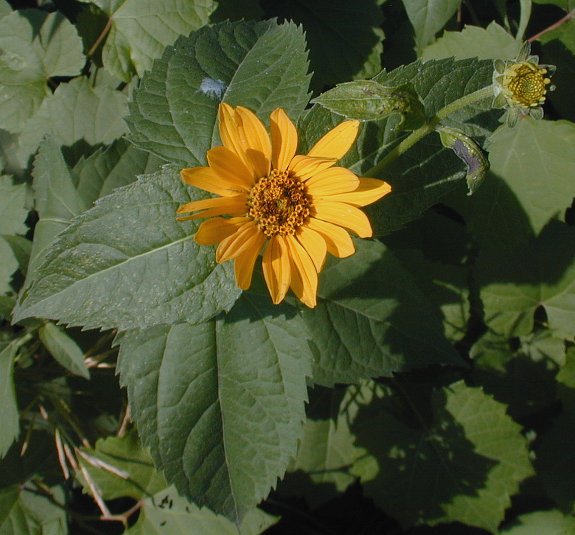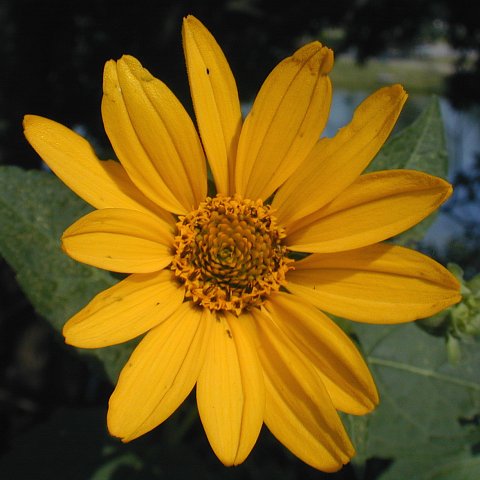Description: This perennial plant is 3-5' tall, branching occasionally and becoming rather bushy in open situations. The stems are light green to reddish green, variably pubescent or hairy, and terete to slightly angular. Pairs of opposite leaves are distributed evenly along these stems. These leaves are 2½–5" long and 1–3½" across; they are cordate-ovate, ovate, or lanceolate in shape, while their margins are coarsely serrated. The upper leaf surface is medium to dark green and usually rough-textured from minute stiff hairs, while the lower leaf surface is light green and glabrous to short-pubescent. Primary veins of the leaves are pinnately arranged. On each leaf, 2 prominent lateral veins become separated from the central vein near its base. Secondary veins of the leaves form reticulated networks that are visible on the leaf undersides. The petioles are up to ¾" long, partially winged, and more or less pubescent. The upper stems terminate in flowerheads spanning about 1½–3" across; these flowerheads are usually more or less erect. Each flowerhead consists of 8-20 ray florets that surround numerous disk florets. The petaloid rays of each flowerhead are yellow to deep golden yellow, oblong or oblong-elliptic in shape, and slightly notched at their tips.

The tiny corollas of both the ray florets and disk florets are short-tubular in shape, deep golden yellow to orange-yellow, and 5-lobed; the corolla lobes of these florets are triangular in shape and spreading to recurved. Both the ray florets and disk florets of the flowerheads are fertile. At the base of each flowerhead, there are several outer phyllaries (floral bracts) that are arranged in a single series. These phyllaries are light to medium green, more or less pubescent, and oblong-ovate in shape, tapering abruptly to blunt tips that are somewhat recurved. There are also several inner phyllaries that are arranged in a single series. These phyllaries are similar to the outer phyllaries, but their tips are appressed along the base of the flowerhead, rather than recurved. The peduncles of the flowerheads are 1-6" long, light green, terete to slightly angular, and more or less pubescent. The blooming period occurs from early summer to late summer, lasting about 2-3 months for a colony of plants. Afterwards, the florets are replaced by achenes that are 4-5 mm. long, oblongoid-oblanceoloid in shape, somewhat flattened, and dark-colored. These achenes lack tufts of hair, nor do they have significant scales at their apices. The root system is fibrous.

Cultivation:
The preference is full to partial sun, moist to mesic
conditions,
and loamy soil, although rocky ground and clay-loam are tolerated. This
plant is easy to cultivate and it has a long blooming period during the
summer. Some double-flowered cultivars are available.
Range & Habitat:
The native False Sunflower occurs throughout Illinois, except for a few
southern counties (see Distribution
Map).
It is a fairly common plant, favoring areas that have some
history
of disturbance. Habitats include black soil prairies,
river-bottom
prairies, grassy meadows in wooded areas, open woodlands, woodland
borders, savannas, thickets, limestone glades, banks of streams, and
areas along railroads where prairie remnants occur. False Sunflower
is grown in flower gardens, from which it sometimes escapes into
neighboring waste areas. This plant is also used in prairie
restorations, even though it is more typically found in or around
wooded areas.

Faunal Associations: The nectar and pollen of the flowerheads attract a wide variety of insects, including honeybees, bumblebees, little carpenter bees (Ceratina spp.), digger bees (Melissodes spp.), cuckoo bees (Coelioxys spp., Triepeolus spp.), leaf-cutting bees (Megachile spp.), Halictid bees (Agapostemon spp., Lasioglossum spp.), Andrenid bees (Andrena spp., Heterosarus spp.), thread-waisted wasps (Ammophila spp.) and other wasps, Syrphid flies (Eristalis spp., Toxomerus spp.), bee flies (Exoprosopa spp.), the Goldenrod Soldier Beetle (Chauliognathus pennsylanicus) and other beetles, Painted Lady butterflies (Vanessa spp.) and other butterflies, and skippers (Robertson, 1929). These floral visitors cross-pollinate the flowerheads. Other insects feed on the leaves, stems, seeds, and other parts of False Sunflower. These species include a leaf beetle (Physonota helianthi), leaf-mining larvae of a Tischeriid moth (Astrotischeria heliopsisella), stem-boring larvae of the Rigid Sunflower Borer Moth (Papaipema rigida), floret- and seed-eating larvae of a fly (Melanagromyza virens), and a seed bug (Lygaeus turcicus); see Clark et al. (2004), Microleps website (2010), Covell (1984/2005), Marcovitch (1916), and Hoffman (1996). Little is known about this plant's relationships to vertebrate animals, but they are probably similar to those of sunflowers (Helianthus spp.). Hoofed mammalian herbivores probably browse on the young foliage, while upland gamebirds, granivorous songbirds, and small rodents probably eat the seeds.

Photographic
Location:
The photographs were taken at Kaufman Lake Park in Champaign, Illinois,
near some trees.
Comments:
False
Sunflower (Heliopsis
helianthoides) is not considered a true sunflower (Helianthus sp.)
because both the ray and disk florets of its flowerheads can produce
seeds. In contrast, only the disk florets of sunflowers can produce
seeds. In contrast to both False Sunflower and true sunflowers, only
the ray florets of Silphium
spp.
can produce seeds, while their disk florets are seedless. All of these
species are relatively large and robust plants that produce showy
flowerheads with yellow rays, and they prefer habitats that are at
least partly sunny. False Sunflower resembles many sunflower species,
particularly those that are found in and around woodlands. In addition
to the difference in the fertility of their florets, False Sunflower
can be distinguished by its more erect flowerheads, by the rather
stout and blunt-tipped phyllaries on its flowerheads, and by the
arrangement of its outer phyllaries in a single series. In contrast,
most sunflower species have flowerheads that nod sideways, their
phyllaries are either more slender (linear-lanceolate in shape) or they
are triangular with acute tips, and they have several
overlapping
series of outer phyllaries.